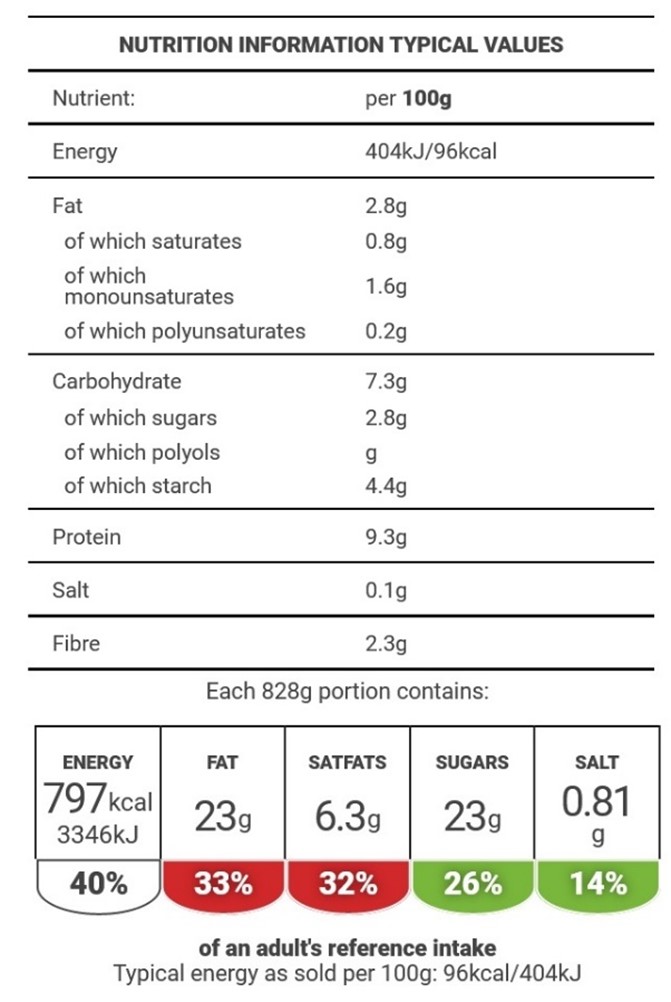It can be tough when buying food to evaluate the nutrient content. This article will help you to decode a nutrition label and understand what each line represents.
Most labels will list nutrients per 100g in the nutrition panel. This makes it easy to see each nutrient as a percentage. Looking at the example shown here, we can see that Fat makes up 2.8 grams of the 100 grams. This means that 100 grams of this food contains 2.8% fat. Within that 2.8% fat, 0.8 grams is listed as saturated fat. That means that 100 grams of this food will contain 0.8% saturated fat.

Saturated fat is something that you want to keep to a minimum as high consumption contributes to a higher risk of heart disease and other cardiovascular-related illnesses. While 0.8% sounds low, you must remember that 100g does not always represent a full portion of the food. Looking at the traffic light boxes you can see that the portion size for this food is 828 grams so the saturated fat is actually very high – counting for 32% of the recommended daily intake – which is why this box is coloured red in the portion information.
Unsaturated fat is also known as ‘good fat’. These good fats contribute to heart health and a reduction of cholesterol. Monounsaturated fats help protect your heart by maintaining levels of “good” HDL cholesterol while reducing levels of “bad” LDL cholesterol in your blood. Polyunsaturated fats are the Omegas that we hear so much about: Omega-3 is mainly found in oily fish (salmon, mackerel, sardines), while Omega-6 is mainly found in plants (rapeseed oil, hemp seeds, pumpkin seeds). These fats also help to reduce the LDL cholesterol.
Many people want to keep their carbohydrate intake low. Carbohydrate includes starch as well as sugar, so do not look at the total carbohydrate value to assess this nutrient. Always look at the ‘of which sugars’ line instead. This gives a representation of the amount of ‘free sugar’ in the food. Free sugar is not added sugar (a common misconception), but what can be immediately absorbed in the body for use as energy.
Protein is relatively simple to understand. The average adult needs approximately 0.8g of protein per kilo of body weight – so if you weigh 70kg, multiply 70 by 0.8 to get your daily recommendation of protein – 56g. Keep in mind that our digestive system cannot process more than 20g of protein in one sitting, so it is best to spread your protein intake through the day, rather than trying to get it all in at once!
Salt must be kept as low as possible (but not at zero – sodium is essential for the heart to function) as too much salt will increase your risk of cardiovascular disease and stroke. The maximum you should be consuming daily is 6g. The label here shows less than 1g of salt per portion so is highlighted green.
Fibre is vital to healthy digestive transit, good bowel health, regulation of blood sugar and lowering of cholesterol. The current recommendation is to consume at least 30g per day. Most ‘traffic light’ labels do not include fibre, and most people do not consume enough. If you are meeting the five-a-day fruit & vegetable recommendation, chances are you will be getting a good quantity. To ensure good fibre intake, choose wholegrains over refined and increase your leafy green vegetables.
Energy is shown in two different ways – by calories (kcal) and kilojoules (kJ). The average adult should be reaching 2000kcal daily (8368kJ). Carbohydrates, fats and proteins release different amounts per gram when digested. Carbohydrates and proteins release 4 calories per gram, with fats releasing 9 calories per gram. This means you need to eat less fat to get the same amount of energy than you would from carbohydrates or proteins.
It is important to keep the right balance from each of these three nutrients. It is recommended that adults consume 45% to 65% of their total calories from carbohydrates, 20% to 35% from fat, and 10% to 35% from protein. This will of course vary depending on your lifestyle and other needs and should be used a rough guide only. Use the Eatwell Plate to help you in your food choices and adapt it to your personal needs.
The Haelan Centre has just launched their online store – www.organictoyourdoor.co.uk – over 6,000 products available direct to your home. Local delivery is free when you spend over £50. Use voucher code OTYD10 to receive 10% off your first order!

*Human Nutrition BSc (Hons) from the University of Westminster to be completed 2021.
